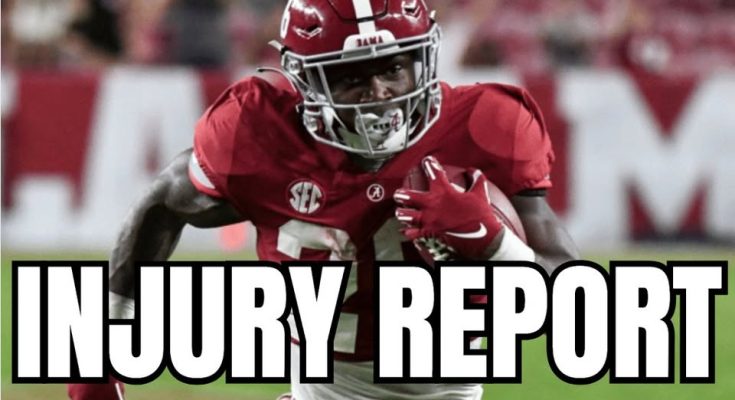Alabama football has long been synonymous with elite talent, dominant performances, and a seemingly never-ending pipeline of players destined for the NFL. Each season, the Crimson Tide enter with high expectations, and every minor setback or injury immediately attracts national attention. This offseason has already seen its share of intense scrutiny as fans, analysts, and opposing programs monitor how Nick Saban’s team shapes up for the upcoming season. One development, however, has sent ripples of concern through the Alabama football community: star running back Jam Miller suffered an injury during a recent team scrimmage, raising serious questions about the backfield’s stability and the broader offensive outlook for the Crimson Tide in 2025.
Jam Miller has been a cornerstone of Alabama’s offense since his freshman year, showcasing a combination of speed, agility, and football IQ that makes him difficult for defenses to contain. His ability to break tackles, find seams, and deliver explosive plays has consistently made him a go-to weapon for the Crimson Tide. Miller’s presence on the field forces opposing defenses to adjust their game plans, often creating opportunities for receivers and tight ends as defenses stack the box to contain him. His versatility, capable of both inside and outside runs, as well as pass-catching ability out of the backfield, has made him an integral part of Alabama’s offensive identity. Losing him, even temporarily, could have profound consequences for the team’s offensive rhythm and overall effectiveness.
The injury itself occurred during a high-intensity scrimmage held at Alabama’s state-of-the-art facilities. While details on the specific nature of the injury remain somewhat limited, reports indicate that Miller was forced to leave the field mid-practice and received immediate attention from the team’s medical staff. Alabama’s training staff has a reputation for thorough care and meticulous injury management, often combining state-of-the-art rehabilitation techniques with a highly individualized approach. Nevertheless, any injury to a player of Miller’s caliber naturally invites speculation, given the high stakes of a college football season and the pressure to perform at championship levels.
The timing of this injury is particularly concerning for the Crimson Tide. Alabama’s schedule is notoriously demanding, often pitting them against top-tier programs in back-to-back weeks, requiring both depth and durability across all positions. The running back position is especially critical, as a well-rounded ground game not only controls the clock but also sets up the passing game by keeping defenses honest. With Jam Miller sidelined, even for a short period, the team may need to rely on less experienced backs or adjust their offensive schemes to compensate for his absence. This could affect game planning, play-calling, and overall strategy, particularly in the season’s early weeks when establishing momentum is vital.
Alabama’s coaching staff, led by Nick Saban, is no stranger to managing injuries to star players. Saban’s decades of experience at both the collegiate and professional levels have taught him the importance of depth, adaptability, and precise timing when reintegrating key players after injuries. Alabama has a history of successfully navigating injuries to critical personnel, often leaning on highly talented backups and freshmen who quickly adapt to the rigors of SEC football. Nevertheless, the loss of a player like Miller is not inconsequential. While Alabama boasts one of the deepest rosters in college football, the mental and emotional impact of losing a star player can resonate through the locker room, affecting confidence, morale, and on-field cohesion.
From a statistical perspective, Jam Miller’s contributions over the past seasons underscore why this injury is significant. His rushing yardage, touchdowns, and yards-per-carry averages have consistently ranked among the best in the conference, making him not only a key offensive weapon but also a reliable playmaker in high-pressure situations. Analysts often cite his ability to convert third downs, sustain long drives, and execute in critical red-zone scenarios as invaluable to Alabama’s success. Losing that level of production temporarily forces the coaching staff to find creative solutions, whether that involves committee running back approaches, increased reliance on the passing game, or unconventional formations designed to exploit defensive weaknesses.
Beyond the field, Miller’s injury has sparked discussions across fan communities, sports media, and social media platforms. Fans, known for their intense loyalty and high expectations, have expressed concern about how the team will perform without their star running back in peak form. Sports analysts and commentators are speculating on the potential ripple effects this injury could have on Alabama’s national title aspirations, Heisman Trophy considerations, and overall team dynamics. The injury has also reignited conversations about player safety, workload management, and the physical demands placed on top-tier collegiate athletes, particularly in high-contact positions like running back. Miller, who has consistently demonstrated resilience and durability, is now facing one of the first major physical tests of his collegiate career, and how he recovers could set the tone for both his season and Alabama’s overall campaign.
Alabama’s training and medical teams are now tasked with a delicate balancing act: ensuring Miller receives the best possible care while also managing expectations about his return. Modern sports medicine has made significant advances in diagnosing, treating, and rehabilitating athletic injuries, often allowing players to return to competition faster and stronger than in previous eras. Yet, rushing recovery carries risks, including reinjury or compromised performance, which could have long-term implications for both the player and the team. The coaching staff will likely implement a carefully monitored recovery protocol, combining physical therapy, strength training, and potentially modified practice schedules to gradually reintroduce Miller to full-contact scenarios. This process requires not only physical rehabilitation but also mental resilience, as athletes often face anxiety, frustration, and pressure to return quickly while ensuring they are fully ready to perform.
The implications of this injury extend to Alabama’s broader roster management as well. Backup running backs now have an opportunity to step into more prominent roles, testing their readiness and adaptability. This can be both a challenge and an opportunity for the team. While inexperienced players may initially struggle to match Miller’s production, this situation allows coaches to evaluate depth, develop young talent, and potentially uncover hidden gems within the roster. Historically, Alabama has been successful at developing underclassmen into reliable contributors, often turning what initially seemed like setbacks into long-term advantages. The ability of these backups to rise to the occasion will be a critical factor in determining how much the team’s performance is affected by Miller’s absence.
Additionally, opposing teams are likely to take note of Miller’s injury, adjusting their defensive strategies accordingly. SEC defenses are notoriously aggressive and opportunistic, and knowing that Alabama’s star running back may be limited could influence game planning, blitz packages, and coverage schemes. While this gives opponents a potential tactical advantage, it also presents an opportunity for Alabama’s coaching staff to innovate offensively, utilizing misdirection, diverse personnel groupings, and creative schemes to maintain offensive balance. The strategic chess match between teams in the SEC is intense, and even small shifts in player availability can have outsized effects on the outcome of high-stakes games.
Alabama’s leadership, both among coaches and players, will play a pivotal role in navigating this challenge. Veteran players, team captains, and experienced coaches must maintain focus, morale, and cohesion as the team adapts to the temporary loss of a key contributor. The culture of resilience, discipline, and accountability cultivated by Nick Saban over decades is likely to serve as a stabilizing force. Players will be expected to step up, maintain high standards in practice, and support one another as the team adjusts its approach. This leadership is critical in ensuring that the injury does not become a psychological setback, but rather a rallying point for the team to demonstrate depth, adaptability, and collective determination.
From a recruiting and future outlook perspective, Jam Miller’s injury may also influence how Alabama evaluates talent at the running back position moving forward. Coaches constantly assess the durability, performance, and readiness of both current players and incoming recruits, understanding that injuries are an inherent part of football. The ability to manage and develop depth in key positions can be a decisive factor in sustained program success. By observing how backup players respond in Miller’s absence, Alabama can make more informed decisions about future recruiting priorities, positional depth, and player development strategies, ensuring the program remains competitive for years to come.
Ultimately, Jam Miller’s injury is a reminder of the physical demands and inherent risks of collegiate football, particularly at programs that compete at the highest levels like Alabama. While the timing and nature of the injury are concerning, the Crimson Tide have demonstrated a remarkable capacity for resilience, adaptability, and depth management under Nick Saban’s leadership. How the team navigates this challenge will be closely watched by fans, analysts, and opponents alike, as it may provide insight into the depth of Alabama’s roster, the effectiveness of its coaching staff, and the overall resilience of its players. Jam Miller’s recovery and eventual return to the field will undoubtedly be a focal point for the team, and how Alabama responds in the immediate aftermath of this setback could define the trajectory of their 2025 season.



